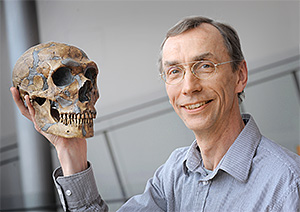
Have you ever wondered how humans lived on Earth before the first major civilizations formed? It turns out that we were not the only hominid species on Earth in those times: other relatives of humans, such as Neanderthals, lived and intermingled with humans. The genetic relationship between humans and these hominids is a subject of great interest to the scientific community, since the traits of our species’s distant relatives can explain genetic phenomena in modern humans. On October 3rd, 2022, the Nobel Prize Committee announced they would be awarding Swedish geneticist Svante Pääbo the prize in Physiology or Medicine “for his discoveries concerning the genomes of extinct hominins and human evolution” (NobelPrize.org, 2022). One of Dr. Pääbo’s most significant achievements leading to his prize was sequencing the Neanderthal genome. A closer look at Dr. Paabo’s work in the field of genetics elucidates how his work led to the foundation of the field of paleogenetics.
Originally a student of Egyptology, Dr. Pääbo received a Ph.D. in molecular immunology from the University of Uppsala in 1986, but his interest in the former remained: his first Nature publication was about cloning ancient DNA from ancient Egyptian mummies (Gruber Foundation, 2022; Pääbo, 1985). Despite the possibility of degradation or contamination from the mummification process itself and from the millenia that passed since, he found that surface-level tissue samples in a one-year old boy yielded DNA that could be cloned using DNA recombination techniques (Pääbo, 1985). Since publishing this, Dr. Pääbo has made a career of refining techniques that allow the sequencing of genomes from many other types of ancient humans or hominins.
Dr. Pääbo’s discoveries have advanced the field of paleogenomics, the study of genomes belonging to extinct species. Of primary concern is recovering ancient DNA (aDNA) from specimens in ideal physical conditions, as in dry and high-salinity environments, since in those environments long DNA molecules will not degrade as fast (Lan, 2019). Then, with techniques such as polymerase chain reaction (PCR) and Sanger sequencing, the aDNA molecules can be cloned and amplified to allow scientists to study copies of genes without needing more of the original sample (Lan, 2019). Storing individual genes from these recovered genomes in bacteria allows scientists to form “libraries” of specimen genomes. The contents of these genomic libraries can then be analyzed to fully sequence the genome of the specimen. After sequencing the genome of one species, scientists can then compare the genome to a related species to identify the differences (Genome.gov, 2020).
In 2010, Dr. Pääbo and colleagues published “A Draft Sequence of the Neandertal Genome,” where they collected and analyzed aDNA from three individual Neanderthal specimens in Europe using the techniques described above (Green, 2010). Using data from this draft genome of the Neanderthal, they identified key genetic differences between modern humans and ancestral species. In particular, there were mutations in certain genes associated with disorders in modern humans, such as in RUNX2. Mutations of the RUNX2 gene can lead to cleidocranial dysplasia, a disorder that causes protruded frontal bones on the cranium and bell-shaped rib cages. These symptoms resemble the known skeletal morphologies of Neanderthals, which gives researchers a clue as to how humans and Neanderthals diverged genetically from each other (Green, 2010).
The discoveries that Dr. Pääbo made in the field of paleogenomics have brought to light how molecular differences between Neanderthals and humans translate to their defining features as species. With the techniques that he developed, scientists can now examine the genomes of specimens thousands of years old without fear of contamination. Future developments in the field of paleogenomics could be expanding upon the links between Neanderthal DNA in human genomes and risk factors for diseases like COVID-19, which Dr. Pääbo himself has contributed to (Zeberg & Pääbo, 2021). Svante Pääbo’s work will help scientists uncover further links between our distant ancestors and modern humans for decades to come.
Works Cited:
Callaway, E., & Ledford, H. (2022). Geneticist who unmasked lives of ancient humans wins medicine Nobel. Nature, 610(7930), 16–17. https://doi.org/10.1038/d41586-022-03086-9
DNA Sequencing Fact Sheet. (n.d.). Genome.Gov. Retrieved November 6, 2022, from https://www.genome.gov/about-genomics/fact-sheets/DNA-Sequencing-Fact-Sheet
Green, R. E., Krause, J., Briggs, A. W., Maricic, T., Stenzel, U., Kircher, M., Patterson, N., Li, H., Zhai, W., Fritz, M. H.-Y., Hansen, N. F., Durand, E. Y., Malaspinas, A.-S., Jensen, J. D., Marques-Bonet, T., Alkan, C., Prüfer, K., Meyer, M., Burbano, H. A., … Pääbo, S. (2010b). A Draft Sequence of the Neandertal Genome. Science, 328(5979), 710–722. https://doi.org/10.1126/science.1188021
Lan, T., & Lindqvist, C. (2019). Paleogenomics: Genome-Scale Analysis of Ancient DNA and Population and Evolutionary Genomic Inferences. In O. P. Rajora (Ed.), Population Genomics: Concepts, Approaches and Applications (pp. 323–360). Springer International Publishing. https://doi.org/10.1007/13836_2017_7
Pääbo, S. (1985). Molecular cloning of Ancient Egyptian mummy DNA. Nature, 314(6012), Article 6012. https://doi.org/10.1038/314644a0
The Nobel Prize in Physiology or Medicine 2022. (n.d.-a). NobelPrize.Org. Retrieved October 16, 2022, from https://www.nobelprize.org/prizes/medicine/2022/advanced-information/
The Nobel Prize in Physiology or Medicine 2022. (n.d.-b). NobelPrize.Org. Retrieved October 16, 2022, from https://www.nobelprize.org/prizes/medicine/2022/press-release/
The Nobel Prize in Physiology or Medicine 2022. (n.d.-c). NobelPrize.Org. Retrieved October 16, 2022, from https://www.nobelprize.org/prizes/medicine/2022/paabo/facts/
Svante Pääbo | Gruber Foundation. (n.d.). Retrieved October 16, 2022, from https://gruber.yale.edu/genetics/svante-p-bo
Svante Pääbo—Max Planck Institute for Evolutionary Anthropology. (n.d.). Retrieved October 22, 2022, from https://www.eva.mpg.de/genetics/staff/paabo/#c28042
Warren, M. (2018). Mum’s a Neanderthal, Dad’s a Denisovan: First discovery of an ancient-human hybrid. Nature, 560(7719), 417–418. https://doi.org/10.1038/d41586-018-06004-0
Zeberg, H., & Pääbo, S. (2021). A genomic region associated with protection against severe COVID-19 is inherited from Neandertals. Proceedings of the National Academy of Sciences, 118(9), e2026309118. https://doi.org/10.1073/pnas.2026309118
Zeberg, H., & Pääbo, S. (2021). A genomic region associated with protection against severe COVID-19 is inherited from Neandertals. Proceedings of the National Academy of Sciences, 118(9), e2026309118. https://doi.org/10.1073/pnas.2026309118